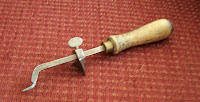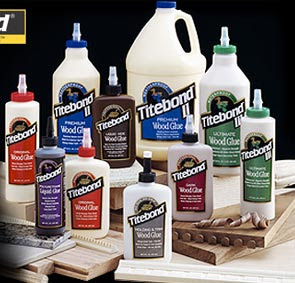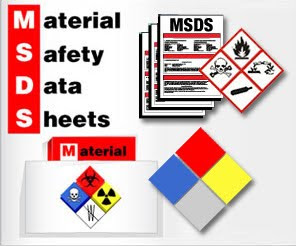 The pictures tell the story. The "tool" is a kitchen tool - but then almost everything used to come in a sealed can. Heck, I think somewhere in my tools I still have a piercing spout for motor oil.
The pictures tell the story. The "tool" is a kitchen tool - but then almost everything used to come in a sealed can. Heck, I think somewhere in my tools I still have a piercing spout for motor oil.So, it makes sense that he / his father would have a can opener in with his other woodworking / home maintenance / construction equipment. I have a "church key" combination bottle / can opener in my tool box that future generations may puzzle over.
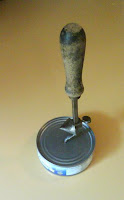 It does work amazingly well. Jab the center of the lid, adjust the cutter to the edge of the can, plunge it, grip can with one hand, turn can opener around until you either free the lid, or leave the lid attached and pull free with the point of the opener.
It does work amazingly well. Jab the center of the lid, adjust the cutter to the edge of the can, plunge it, grip can with one hand, turn can opener around until you either free the lid, or leave the lid attached and pull free with the point of the opener.I think the downside of the tool is having to grip the can while using it - which is why the crank style can opener won out. It is at its worst with a small can like the pictured can of tuna. Simply less can to grip.
Here we have jabbed as accurately as possible.
 Next, we engage the cutter, which has been moved and tightened for this size can.
Next, we engage the cutter, which has been moved and tightened for this size can. Here we have pulled the cutter most of the way around the can. (This part is pretty quick, although we haven't tried a can race between electric, hand crank and this old fellow yet.)
Here we have pulled the cutter most of the way around the can. (This part is pretty quick, although we haven't tried a can race between electric, hand crank and this old fellow yet.)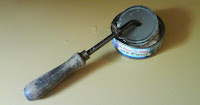 And a last picture with the lid nearly removed and hinged up from the can.
And a last picture with the lid nearly removed and hinged up from the can.

